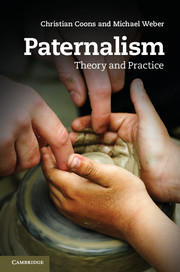Book contents
- Frontmatter
- Contents
- Contributors
- Introduction Paternalism – Issues and trends
- Chapter 1 Defining paternalism
- Chapter 2 Penal paternalism
- Chapter 3 Self-sovereignty and paternalism
- Chapter 4 The right to autonomy and the justification of hard paternalism
- Chapter 5 Moral environmentalism
- Chapter 6 Kantian paternalism and suicide intervention
- Chapter 7 Paternalism and the principle of fairness
- Chapter 8 Paternalism in economics
- Chapter 9 Choice Architecture: A mechanism for improving decisions while preserving liberty?
- Chapter 10 A psychological defense of paternalism
- Chapter 11 Libertarian paternalism, utilitarianism, and justice
- Chapter 12 Voluntary enslavement
- Chapter 13 Paternalism, (school) choice, and opportunity
- Bibliography
- Index
Chapter 10 - A psychological defense of paternalism
Published online by Cambridge University Press: 05 February 2013
- Frontmatter
- Contents
- Contributors
- Introduction Paternalism – Issues and trends
- Chapter 1 Defining paternalism
- Chapter 2 Penal paternalism
- Chapter 3 Self-sovereignty and paternalism
- Chapter 4 The right to autonomy and the justification of hard paternalism
- Chapter 5 Moral environmentalism
- Chapter 6 Kantian paternalism and suicide intervention
- Chapter 7 Paternalism and the principle of fairness
- Chapter 8 Paternalism in economics
- Chapter 9 Choice Architecture: A mechanism for improving decisions while preserving liberty?
- Chapter 10 A psychological defense of paternalism
- Chapter 11 Libertarian paternalism, utilitarianism, and justice
- Chapter 12 Voluntary enslavement
- Chapter 13 Paternalism, (school) choice, and opportunity
- Bibliography
- Index
Summary
Introduction
Visceral objections often exist to policies seen as “paternalistic.” Terms like “Big Brother” and the “nanny state” invoke the dire specter of government intrusion into individuals’ thoughts, feelings, and behavior. Indeed, “paternalism” itself is often a term of opprobrium, used to disparage or reject policies without necessarily addressing their merits or demerits. Economists are traditionally hostile to paternalism; public policy-makers and legal academics tend to be as well. Even those recognizing the implications of social science research indicating that individuals tend to make non-optimal decisions and to be vulnerable to a host of cognitive and emotional biases, hesitate in acknowledging the paternalistic implications of their results. Public opinion, too, is seen to oppose paternalistic policies; citizens are presumed to object to any government infringement on their rights or autonomy. Opposition tends to focus on such autonomy objections – emphasizing a libertarian ideal that each person prefers, and should be free, to make his own decisions, even if those decisions result in negative outcomes for the individual. If they do, the argument runs, then they will learn from those mistakes. Taking such objections into account, some scholars, as something of a compromise, have developed alternatives to traditional paternalism – e.g., “light,” “libertarian,” or “asymmetric” paternalism – that they argue accrue benefits to non-optimal decision-makers but retain autonomy of choice as much as possible.
Keywords
- Type
- Chapter
- Information
- PaternalismTheory and Practice, pp. 197 - 215Publisher: Cambridge University PressPrint publication year: 2013
- 6
- Cited by

